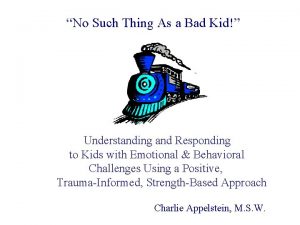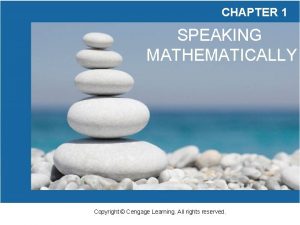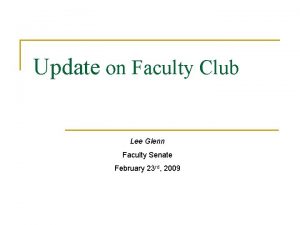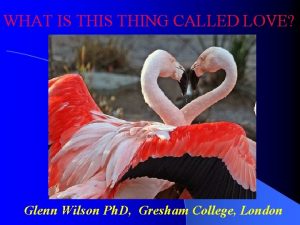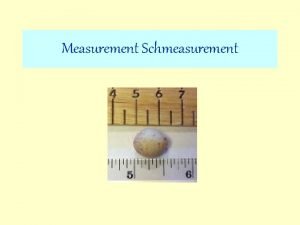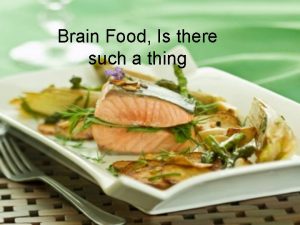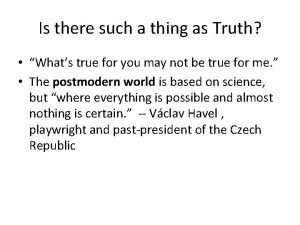IS THERE SUCH A THING Glenn Wilson Ph



























- Slides: 27

IS THERE SUCH A THING? Glenn Wilson Ph. D, Institute of Psychiatry, King’s College, University of London

FOUR MAIN AREAS 1. Attraction 2. Arousal 3. Romantic love 4. Relationship stability

IS THIS AN ATTRACTIVE FACE? WHY?

SOME PRINCIPLES OF ATTRACTION l l l Baby faces are attractive in women; tougher, swarthier looks for men. Symmetry is attractive in both sexes A low waist/hip ratio is attractive in women; tall, V-shaped men more attractive. Vulnerability is attractive in women; ruthlessness in men (needing protection vs commanding resources). Deep voice attractive in men; higher voice in women. These are signals of oestrogen/fertility (women); testosterone/power (men), or signs of general health/youth.


SNIFFING OUT COMPLEMENTARY GENES Smell preferences may be connected with a search for complementary genes that will broaden the immunity spectrum of our offspring. l Human leukocyte antigens (HLAs) govern our immune system and can be detected in body odour. l Some evidence that we prefer different HLAs when breeding, but similar HLAs when needing family support (e. g. when pregnant). l

TRIGGERS FOR SEXUAL AROUSAL l These are based on innate releasers (stored sexual signals, c. f. , instincts/archetypes). l Depend on visual templates (esp. for males). l Consolidated or modified by early childhood imprinting (inappropriate = fetishism). l Habituation occurs to particular exemplars, esp. males (Coolidge Effect).

An IRM for the human male?

Female front Female rear Male front

CHILDHOOD IMPRINTING OF SEX TARGETS Cross-fostering studies reveal importance of mother-image. Lambs raised by a goat mother (left) and kids raised by a sheep mother (right) fancy the “wrong” species when grown up (effect esp. obvious for males, who depend more on “targets”. )

Other “Oedipal” imprinting studies Japanese quail raised by albino mothers prefer albino mates (Bateson 1978). l Hawaiians of mixed race tend to marry into ethnic group of opposite-sex parent (Jedlicka 1980). l Women fall in love with men of eye colour more similar to their father than mother (Wilson & Barrett 1987). l Photos of wives correctly matched by external judges to mothers-in-law beyond chance (Bereczkei et al 2002). l

The compulsive attraction of close relatives reared apart (Star 18/1/88)

Female f. MRI (BOLD) responses to attractive males Brain areas activated as a young woman views eligible male faces & bodies (those linking cortical pattern processing with limbic emotional areas).

Female f. MRI (BOLD) responses to five different men Male rated most desirable to date 1 2 3 4 5

LOVE IN THE BRAIN f. MRI has also been used to find areas of brain active when love is experienced. e. g. Brain responses to pictures of a loved partner are compared with responses to pictures of friends. Or, brain responses to romantic pictures are compared with responses to explicit erotica. Brain areas concerned with love are the emotional/social areas such as the amygdala and insula; those concerned with lust are more “animal” (e. g brain stem and hypothalamus).

CONDITIONS FAVOURING LOVE High arousal (even negative) promotes love bonds. l Gazing into each others eyes and sharing intimate details about oneself (mutual selfdisclosure)may create love in the laboratory. l Sexual arousal and pleasure evoke a hormone called oxytocin (also responsible for mother/child bonding). l Being in love shares brain chemistry with obsessional/compulsive states (low serotonin) l

ARE WE NATURALLY MONOGAMOUS? Very few animals are monogamous, and even fewer mammals. Gibbon may be only primate. l Most human societies recognise polygamy; those that don’t tend towards serial monogamy. l Males of most species have greater drive towards partner novelty (promotes gene dispersion). l Women may also benefit from infidelity; more attracted to lovers when fertile. But may flirt just to keep partner on his toes. l

“DON JUAN” GENES This meadow vole is normally promiscuous, but a gene that increases production of a hormone in the brain called vasopressin, transferred from the monogamous prairie vole, renders it faithful to one partner

IS THERE A SEVEN-YEAR ITCH? Asked “Ever wished you weren’t married? ”, 1 in 5 wives said “yes”, and 1 in 7 husbands. Peak discontent occurs 6 -9 years after marrying, though actual divorce peaks later (11 -14 years).



A COMPATIBLE PAIR: SHARED TASTES

THE COMPATIBIITY QUOTIENT l l l The CQ Test is designed to predict long-term success of a relationship (after passion has cooled). Comprises 25 items covering areas known to be important for relationship success. Answered independently by individuals. Each item has 5 possible answers arranged so that those further apart clash more. A total discrepancy score is calculated between the responses of any two people and converted to a CQ score with an average of 100.

A TYPICAL CQ TEST ITEM How important to you is sexual fidelity? 1. Absolutely essential 2. Very important 3. Odd lapse forgivable 4. You have to expect affairs 5. Would want an open, swinging, relationship

MEANING OF CQ SCORES l l l l 145+ Freak identity: Typical of test-retest reliability (same person doing the test twice) or identical twins. 130 -144 Extremely compatible: Exceptionally high degree of similarity. <2% of couples. 115 -129 Very compatible. <20% of couples. 100 -114 Above average. Might work but issues to be dealt with. 85 -99 Below average. Warning bells sounding. 70 -84 Rather incompatible. Loud warning bells. <70 Incompatible. Don’t even think about it!

VALIDITY OF THE CQ Two studies have shown that happily married couples average about 116, compared with 100 for random pairings. l Those reporting the happiest marriages have the highest CQ scores. l This is not due to the couple growing more alike with time but to their degree of similarity at the outset of the relationship. CQs even predict the outcome of a 3 minute speed-date. l The CQ has application in on-line dating and marriage counselling - an early warning of potential difficulties in a relationship. l

WHY ARE WE SO FASCINATED BY LOVE? l The reproductive imperative is our most powerful instinct – perhaps the only one (“selfish gene” hypothesis). l “The final aim of all love intrigues, be they comic or tragic, is really of more importance than all other ends in human life. What it all turns upon is nothing less than the composition of the next generation” (Schopenhauer, 1819)
 There's no such thing as a free lunch artinya
There's no such thing as a free lunch artinya There is no such thing as absolute security
There is no such thing as absolute security There is no such thing as a bad kid
There is no such thing as a bad kid One thing i ask of the lord
One thing i ask of the lord There is no wrong way to do the right thing
There is no wrong way to do the right thing Rewriting an existential universal statement
Rewriting an existential universal statement It was a man in russia long ago
It was a man in russia long ago Speaking mathematically variables
Speaking mathematically variables Glenn york elementary
Glenn york elementary Dr sarah song
Dr sarah song Glenn samaai
Glenn samaai Glenn nathan
Glenn nathan Glenn cheney
Glenn cheney Glenn hubbard net worth
Glenn hubbard net worth Glenn haddox
Glenn haddox Redaction criticism definition
Redaction criticism definition Patctech
Patctech Tony lee glenn
Tony lee glenn Glenn heirman
Glenn heirman Patricia fagan md
Patricia fagan md Glenn nathan
Glenn nathan Glenn proctor
Glenn proctor Glenn ahrens
Glenn ahrens Glenn bard
Glenn bard Glenn hubbard inside job
Glenn hubbard inside job Glenn dion
Glenn dion Glenn christie
Glenn christie Glenn maleyko
Glenn maleyko


